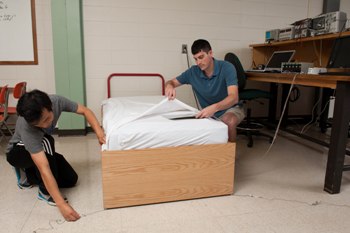Jun 11 2014
A group of Kansas State University engineers and students are developing technology to improve the health and quality of life for children with severe developmental disabilities.
 Kansas State University engineering students have created mattress and bed sensors that track breathing rates, heart rates and movement of children while they are sleeping and potentially can alert paraeducators of seizures. (Credit: Kansas State University)
Kansas State University engineering students have created mattress and bed sensors that track breathing rates, heart rates and movement of children while they are sleeping and potentially can alert paraeducators of seizures. (Credit: Kansas State University)
Steven Warren, associate professor of electrical and computer engineering, and Punit Prakash, assistant professor of electrical and computer engineering, are collaborating with Heartspring Inc. The Wichita-based nonprofit organization is a therapeutic residential and day school program that uses evidence-based and emerging best practices to serve students who often have multiple diagnoses, including autism spectrum disorders, cerebral palsy, speech and language impairments, and other developmental disabilities.
The collaborative work is supported by a five-year $125,000 grant from the National Science Foundation's General and Age-Related Disabilities Engineering program.
The professors are using the grant to teach senior design courses where engineering students develop customized devices and software to help children at Heartspring. The professors and students collaborate with Heartspring administrators, clinicians and paraeducators to understand the needs of these children. Most of the children have a primary diagnosis of autism and a majority are nonverbal.
"The intent of this program is to pursue a specific design for a specific child when possible," Warren said. "When we are finished with a design, that individual would then get to keep and use a copy of the design. This is research where you can add immediate benefit to these children's lives."
The design courses began in fall 2011. Nearly 30 professors and students took part on design teams during the 2013-2014 academic year. The courses have involved several engineering departments, including electrical and computer engineering; mechanical and nuclear engineering; biological and agricultural engineering; and industrial engineering.
In some of these courses, students learn about bioinstrumentation and how to develop sensors and hardware to measure physiological signals.
"It's often the students' first exposure to an open-ended design problem," Prakash said. "They identify a specific problem and propose how they can address that. It's a real-world problem, similar to the kind they will work on throughout their professional careers."
Some of the student-developed projects so far have included:
- Smartphone tools and apps to help paraeducators track and record children's behavioral, physiological and cognitive development.
- Wearable sensors, such as accelerometers, that can be placed in shoes or clothing to monitor self-abusive behaviors. The engineers are working with Minyoung Suh, assistant professor of apparel, textiles, and interior design, to develop wearable sensors embedded in clothing.
- A musical toothbrush that tracks brushing activity and plays different songs so children know how long to brush the different areas of their mouths.
- Multi-touch surface computer games that teach children how to sort items, take turns and interact with other children.
- An adjustable stand for these multi-touch surface computers.
- Mattress and bed sensors that track breathing rates, heart rates and movement of children while they are sleeping and potentially can alert paraeducators of seizures and bedwetting.
- Shoe sensors to quantify the progress of children learning to walk.
Warren and Prakash are continuing the design courses every semester while the grant is active. When possible, the professors take students to Heartspring so they can tour the facility and better understand the usage environments.
Heartspring leaders continue to see the project's potential to make a difference in the lives of the children with special needs.
"All too often clinicians and teachers don't know what is possible and engineers don't know what is needed," said Gary Singleton, president and CEO of Heartspring. "When the two come together, there is an opportunity to encourage interdisciplinary collaboration and to imagine new solutions to real-world problems."
Other university collaborators include Stephen Dyer, professor of electrical and computer engineering; Kim Fowler, instructor of electrical and computer engineering; Bala Natarajan, professor of electrical and computer engineering; Edwin Brokesh, instructor of biological and agricultural engineering; Garth Thompson, professor of mechanical and nuclear engineering; and Jack Xin, associate professor of mechanical and nuclear engineering.